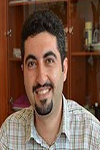Scientific Program
Keynote Session:
Title: Electrochemical biosensors for rapid diagnosis of fungal infections in agriculture
Biography:
Ramaraja Ramasamy is an Associate Professor of Biochemical Engineering in the School of Chemical, Materials and Biomedical Engineering at the University of Georgia. He received his PhD degree in chemical engineering from the University of South Carolina in 2004. After graduation, he held research positions at the Pennsylvania State University and Air Force Research Laboratory before joining the University of Georgia in 2010. His research interest lies in non-traditional electrochemical engineering applied to biosensors, bio-solar cells, batteries, fuel cells and related systems. His research group consists of 9 graduate and undergraduate students and postdocs. He has authored over 65 publications and 6 patents.
Abstract:
Economic losses to agriculture due to pest and pathogen infections are estimated at $40 billion annually and the economic losses to the health care industry due to food borne illnesses are estimated at $15 billion in the U.S. alone. Early detection of pest or pathogen infection in agricultural crops and reliable detection of harmful pathogens in food are important to minimize agricultural productivity loss, ensure food safety, improve food quality and minimize food related public health issues. There is a pressing need to develop rapid, highly selective and sensitive detection technologies for early identification of plant and human pathogens. While a variety of molecular methods are currently being used for this purpose, an inexpensive, high selective, rapid method for the detection of pathogens is highly desired. Electrochemistry biosensors offer unique advantages to this application. Electrochemical sensors have been widely explored for medical and environmental sensing applications, but not as much for food and agricultural applications. An electrochemical biosensor uses a highly selective bio-recognition element such as enzymes, antibody, aptamer or virus and is capable of detecting biding events with ultra-low detection limits. This presentation will focus on some of the recent developments in our lab in the development of electrochemical biosensors for detection of crop diseases and fungal plant pathogens.
A PHP Error was encountered
Severity: 8192
Message: trim(): Passing null to parameter #1 ($string) of type string is deprecated
Filename: pastconference/past-program-schedule.php
Line Number: 239
Backtrace:
File: /efsdata/meetingsint-com/application/views/pastconference/past-program-schedule.php
Line: 239
Function: trim
File: /efsdata/meetingsint-com/application/controllers/Pastconference.php
Line: 128
Function: view
File: /efsdata/meetingsint-com/index.php
Line: 317
Function: require_once
Title: A proteomic approach to identify peptide substrates for sensitive and specific detection of membrane bound proteases
Biography:
Bo Liedberg received his PhD from Linköping University, Sweden, in 1986, and did an industrial post doc at Pharmacia Biosensor, Uppsala, Sweden, in 1986-1989. He is currently the Director of the Center of Biomimetic Sensor Science and serves also as dean for the Interdisciplinary Graduate School, in Nanyang Technological University, Singapore. His research focuses on self-assembly, flexible devices, bioanalytics and fieldable sensor technologies. He has published more than 300 papers in reputed journals. Liedberg also has been serving as an editorial board member and guest editor for numerous journals.
Abstract:
Rational design of synthetic peptides has become a critical step during development of functional (cleavage) assays for proteases. In this study we describe a high throughput proteomic methodology to screen for peptides that are effectively and specifically cleaved by the protease. It is based on rationally designed peptide libraries that are screened using Self Assembled Monolayers Desorption Ionization-Mass Spectrometry (SAMDI-MS)1 to identify potential peptide hits. We start by describing experiments of matrix metalloproteinase-7 (MMP-7)2 a potential cancer biomarker. However, the focus is on Omptin proteases present on the surface of E.coli and Salmonella. These membrane proteases, e.g. OmpT and PgtE, serve as a defense mechanism and contribute to the virulence of various pathogenic strains by inactivating/digesting host generated antimicrobial peptides. We demonstrate that the catalytic efficiency (kcat/K M) of OmpT targeting LL37, an anti-microbial peptide and a natural substrate to OmpT, can be improved ~400-fold by replacing natural cleavage sequence ARRA with and FRRV identified from a SAMDI-MS screening3. A portion of the FRRV-modified LL37 peptide was subsequently employed in a fluorescent quenching assay enabling detection of OmpT in detergent micelles down to about 2 nM. It is also shown that it is possible detect at least 104 CFU/mL E.coli cells with over expressed levels of OmpT in the membrane as well as wild type E. coli K12 cells. This is fully comparable to the sensitivity levels obtained by commercial culture-independent test kits opening up for rapid detection of pathogenic strains of E.coli and other bacteria.
Title: Point-of-care testing of nitrites: In the route to market
Biography:
Gabriela Almeida received her undergraduate education in Chemistry at Universidade de Lisboa and the Master’s degree in Biotechnology from Universidade Técnica de Lisboa. She completed her Doctoral studies in Biochemistry (2003), at Universidade Nova de Lisboa. She is the Associate Professor at Instituto Universitário Egas Moniz and the head of the Group of Biomarkers and Biosensors (https://gb29.webnode.pt). Her main research interests are focused in the discovery of novel biomarkers through proteomic techniques and the development of point-of-care tests based on enzyme electrochemical biosensors.
Abstract:
The quantification of nitrites (NO2-) has gained an increasing relevance in biomedicine due to its recognition as a central homeostatic species in the NO physiology, as well as an important signalling molecule. Though, the circulating levels of nitrites in body fluids have been difficult to measure due to sampling issues and the poor performance of common diagnosis methods. In clinical applications, the detection of nitrites in urine is widely used, as a marker of NO production under infection and/or inflammatory conditions. Thus, the implementation of an effective and easy-to-use point-of-care-test (POCT) for quick and effective NO2- readings would be surely welcome either in translational medicine or clinical diagnosis. Other markets for nitrites testing exist in the food industry, and pollution control (the main international authorities, for instance, have promulgated rules restricting nitrite concentrations in drinking water and foodstuff). Our research group has been focused on the construction of a POCT for nitrites quantification using enzyme-based electrochemical biosensors. In this communication, the progress made over the last years will be shortly reviewed. Several second generation biosensors using redox mediators were initially proposed. These were followed by several third generation configurations based on a direct electron transfer approach. Recently, the electrodes system was fully miniaturized using disposable screen-printed electrodes and the proof-of-concept was established. The technology is now mature to start its transference into the market.
Oral Session 1:
- Biosensors |Biosensor Applications | Bio-sensing Technology |Amperometric Biosensor | Bioelectronics

Chair
Maria Gabriela Almeida
Instituto Universitario Egas Moniz
Portugal

Co-Chair
Tom Zimmerman
Michigan State University
USA
A PHP Error was encountered
Severity: 8192
Message: trim(): Passing null to parameter #1 ($string) of type string is deprecated
Filename: pastconference/past-program-schedule.php
Line Number: 354
Backtrace:
File: /efsdata/meetingsint-com/application/views/pastconference/past-program-schedule.php
Line: 354
Function: trim
File: /efsdata/meetingsint-com/application/controllers/Pastconference.php
Line: 128
Function: view
File: /efsdata/meetingsint-com/index.php
Line: 317
Function: require_once
Title: The potential capability of deep learning in cardiac arrhythmia classification
Biography:
Janet M. Wang-Roveda is a Professor in the Department of Electrical and Computer Engineering at the University of Arizona in Tucson. She received her M.S. and Ph.D. degrees in Electrical Engineering and Computer Sciences from the University of California, Berkeley in 1998 and 2000, respectively. She was a recipient of the NSF career award and the Presidential Early Achievement Award for Science and Engineering at White House in 2005 and 2006, respectively. She was the recipient of the 2008 R. Newton Graduate Research Award from the EDA community, the 2007 USS University of Arizona Outstanding Achievement Award, the 2016 Da Vinci Award, and the 2017 ACABI fellow for the Biomedical Engineering Advancement. She received the best paper award in journal of clean energy in 2013, ISQED 2010 as well as best paper nominations in ASPDAC 2010, ICCAD 2007, and ISQED 2005. Her primary research interests focus on robust VLSI circuit design, biomedical instrument design, Smart grid, VLSI circuit modeling/design and analysis, and low power multi-core system design. She has over 200 publications.
Abstract:
Cardiac arrhythmia symptoms are detected by ECG devices with at least 8 leads. Due to the large amount of data, arrhythmia classification with high precision is usually performed by cardiologists with considerable time consumption. Automatic arrhythmia classifiers based on an artificial intelligence algorithm can help cardiologists to obtain better precision and reduce time-consumption. In this presentation, we compare optimization methods, machine learning methods, and deep learning methods in cardiac arrhythmia classification. A high-performance classifier based on a deep learning algorithm is a viable direction of the future research.
A PHP Error was encountered
Severity: 8192
Message: trim(): Passing null to parameter #1 ($string) of type string is deprecated
Filename: pastconference/past-program-schedule.php
Line Number: 354
Backtrace:
File: /efsdata/meetingsint-com/application/views/pastconference/past-program-schedule.php
Line: 354
Function: trim
File: /efsdata/meetingsint-com/application/controllers/Pastconference.php
Line: 128
Function: view
File: /efsdata/meetingsint-com/index.php
Line: 317
Function: require_once
Title: Detection of β-thalassemia mutations by using piezoelectric biosensor for noninvasive prenatal diagnosis
Biography:
Umut Kokbas has studied biotechnological biochemistry at Ege University. His profession is in medical biosensor applications. He is a Research Assistant at Medical Biochemistry Department at Cukurova University and working about genetic and, enzymatic biosensors. He has completed the PhD at Cukurova University, Turkey.
Abstract:
β-Thalassemia is one of the most monogenic autosomal recessive disorder characterized by defective production of the β-chain of hemoglobin. Definition of the β-globin genotype is necessary for genetic counselling in the carriers, and for predicting prognosis and management options in the patients with thalassemia. DNA-based prenatal diagnosis of β-thalassemias routinely relies on polymerase chain reaction (PCR) and gel electrophoresis. The aim of this study is to develop a new procedure, a DNA-based piezoelectric biosensor, for the detection of β-thalassemia mutations fetus’ cell-free DNA from maternal blood, the most common β-thalassemia mutation in Turkey. Cell-free fetal DNA can take from maternal whole blood. Bioactive layer may constituted by binding 2-Hidroxymetacrilate Metacriloamidoscystein (HEMA-MAC) nanoploymers on the electrode’s surface. Single oligonucleotide probes specific for mutations of β-thalassemia will attached to the nanopolymer. The measurements will execute by piezoelectric resonance frequency which is caused by binding of the cell-free fetal DNA in media with single oligonucleotide probe on the electrode surface. The results must confirmed by the conventional molecular method as ARMS. The piezoelectric resonance frequencies can obtain by hybridization of the cell-free fetal DNA on bioactive layer will found for the samples of normal β-globin, heterozygote, and homozygote of mutations. The developing biosensor will serve as a specific result to mutations. It could accurately discriminate between normal and mutations samples. Because of low costs, fast results, specificity and high detection/information effectiveness as compared with conventional prenatal diagnosis methods, we can be offered this technique as an alternative to conventional methods.
A PHP Error was encountered
Severity: 8192
Message: trim(): Passing null to parameter #1 ($string) of type string is deprecated
Filename: pastconference/past-program-schedule.php
Line Number: 354
Backtrace:
File: /efsdata/meetingsint-com/application/views/pastconference/past-program-schedule.php
Line: 354
Function: trim
File: /efsdata/meetingsint-com/application/controllers/Pastconference.php
Line: 128
Function: view
File: /efsdata/meetingsint-com/index.php
Line: 317
Function: require_once
Title: A low power occlusion dose monitor for compliance to glasses wearing
Biography:
Chenxi Dai is a PhD student at Department of Electrical and Computer Engineering at the University of Arizona. His research interest are low power circuit design for machine learning and reconfigurable caches.
Abstract:
To investigate the effect of Amblyopia treatment involving the wearing of eyeglasses, eyeglass dose monitoring using a wearable sensor provides an objective measure of compliance. Subjective approaches such as diary entries and interviews are open to bias and interpretation, thus are less reliable than objective measurements of compliance. Previous approaches to eyeglass compliance monitoring include thermal and skin resistance sensing. [1] We prototype a device to monitor compliance through motion and thermal tracking, attached to the eyeglasses. Requirements of the device are low power to be able to log data for a long time, small size, child safe, and easy retrieval of data. A magnetometer, accelerometer, and thermistor collect position, movement and thermal data respectively, every second. Compliance with eyeglass wearing is determined through magnetometer and accelerometer data, with thermal data to verify using previous approach by Maconachie et. al.
Keynote Session:
A PHP Error was encountered
Severity: 8192
Message: trim(): Passing null to parameter #1 ($string) of type string is deprecated
Filename: pastconference/past-program-schedule.php
Line Number: 239
Backtrace:
File: /efsdata/meetingsint-com/application/views/pastconference/past-program-schedule.php
Line: 239
Function: trim
File: /efsdata/meetingsint-com/application/controllers/Pastconference.php
Line: 128
Function: view
File: /efsdata/meetingsint-com/index.php
Line: 317
Function: require_once
Title: Automation of biotechnological bioreactor production processes
Biography:
Tom Zimmermann was head of the business unit Biohybrid Systems at Fraunhofer and is with the Michigan State University since 2017. His research activities are in the field of diamond bioMEMS solutions in biomedical diagnostics, automation of biotechnological processes, and food analysis as well as in the development of diamond high-power terahertz systems. He graduated in solid-state electronics at the University Ulm (Germany), in 2002. He received the PhD degree in electrical engineering from the University Ulm (diamond and III-V devices) and joined the University of Notre Dame, in 2006. Where, he pursued research in high-power high-frequency devices, first as a post-doc and later on as research assistant professor. He has published his research in 30+ peer-reviewed journals and presented in 60+ conferences.
Abstract:
The change of health care towards personalized medicine requires an adaptation of the biomedical and pharmaceutical production. The demand for sophisticated and customized products, including monoclonal antibodies, therapeutic proteins and vaccines, is ever growing. At the same time, high efficiency and product quality are key requirements. A personalized and affordable medicine requires low volume and highly parallelized production methods, frequently realized in single-use bioreactors. Complexity and requirements of strictly controlled bioreactor processes are increasing rapidly. A continuous measurement of relevant process parameters and full automation of biotechnological production processes are critical to a high process yield and productivity. Parallel real-time in-situ monitoring of a variety of parameters in complex fluids can be realized by suitable multi-sensor systems (Fig. 1). Integrated disposable in-situ monitoring and control systems are not commercially available, yet. Required systems should control typical parameters of a cell culture in a bioreactor process and monitor various metabolic proteins and lactate, the nutrient glucose and cell density as well as the pH and the temperature. Integrated bioMEMS with a functionalized bioactive recognition layer shall be used to detect in-situ and in real-time most specifically on the biomolecular level bioanalytes of interest in highly complex bioreactor environments. Key for a stable, reliable, and robust in-situ sensor- and actor-system with low bio-fouling property might be the use of highly biocompatible diamond and carbon material systems.
Title: Development, characterization, and application of needle-type microsensors for in situ monitoring of ions in citrus plants
Biography:
Woo Hyoung Lee is an Assistant Professor in the Department of Civil, Environmental, and Construction Engineering (CECE) at the University of Central Florida (UCF). He received his PhD from the University of Cincinnati, OH in 2009. Before joining UCF, he was a Post-doctoral researcher at U.S. Environmental Protection Agency (EPA), National Risk Management Research laboratory, Cincinnati, OH. He has published more than 32 papers in reputed journals and has been serving as an Associate editor of Water Environment Research (WER).
Abstract:
For over a decade, the incidence of Huanglongbing (HLB) has grown at an alarming rate, affecting citrus crops worldwide. Current methods of nutrient therapy have little to no effect in alleviating symptoms of HLB, and scarce research has been put forth towards non-destructive tools for monitoring zinc transport in citrus plants. The present study investigated in situ monitoring of Zn2+ ion transport in citrus plants. We have developed a solid contact micro-ion-selective electrode (SC-µ-ISE) for the determination of zinc transport in sour orange seedlings using a non-invasive microelectrode ion flux estimation (MIFE) technique. Foe better penetrating ability, a metallic bismuth microelectrode was developed for the in situ monitoring of Zn2+ in the vascular bundle of citrus leaves using a novel two-step square wave anodic stripping voltammetry (SWASV) analysis. The SC-µ-ISE displayed a 26.05±0.13 mV decade-1 Nernstian response and a limit of detection (LOD) of 0.026 ppm. The bismuth microelectrode presented a 0.172 µA/ppm Zn2+ response and a LOD of 0.92 ppm Zn2+. Application of these sensors showed a significant Zn2+ uptake in the leaves and roots of sour orange seedlings when bulk concentrations were higher than 5.99 mM. Above this concentration, a linear relationship between flux and bulk Zn2+ concentration was observed which relationship suggests passive diffusion may be a key mechanism for Zn transport into plants. Overall, the developed microsensors, capable of tracking its systemic Zn2+ activity directly in plants will lead to better understanding of its potential fate in plants for effective HLB management.
Oral Session 1:
- Bioprocessing | Bioengineering Applications | Biomedical Engineering | Environmental Biosensor |Biomaterial Science |Biomedical Device

Chair
Bo Liedberg
Nanyang Technological University
Singapore

Co-Chair
Janet Roveda
University of Arizona
USA
Title: Development a label-free plasmonic Apta sensor for pathogenic bacterial detection
Biography:
Heba Khateb is a PhD student at Interdisciplinary Nano science Center at the University of Aarhus. Her research interests are label-free Plasmonic Apta sensor for pathogenic bacterial detection.
Abstract:
A localized surface plasmon resonance (LSPR)-Aptasensor that based on an immobilized DNA aptamer is developed and used for the label-free of pathogenic bacteria detection. In this project, the role of LSPR element size in the bacteria detection process is addressed by integrating fabricating multiple different sized nanosensors funtionalised with DNA aptamer. Colorometric bacterial detection was compared at gold nanodisks of 100 or 200 nm diameter. The concept is to open up LSPR sensors for detecting the main four pathogen threating the food safety and causing food-poisoning outbreaks; Salmonella Typhimurium, Staphylococcus aureus, Listeria Monocytogenes and E.coli.
The hole musk colloidal lithography (HMCL) has been used for the fabrication of short range ordered arrays of 100 or 200nm diameter (and 20nm high) Au nanodisks. A specific aptamer for S, aureus with a free thiol bond was immobilized to the gold nanodisks in different concentrations (10 or 20 µM). Changes in local refractive index around the nanodisks after bacterial capture (from approximately 106 cfu/ml after 30 or 60 minutes) showed significantly larger resonant wavelength shifts for 200nm nanodisks (~4.33nm) compared to 100nm (~0.31nm). The larger signal was a combination of higher bulk refractive index sensitivity of the longer wavelength resonance of the larger nanodisk and a more extended sensitive region.
A PHP Error was encountered
Severity: 8192
Message: trim(): Passing null to parameter #1 ($string) of type string is deprecated
Filename: pastconference/past-program-schedule.php
Line Number: 354
Backtrace:
File: /efsdata/meetingsint-com/application/views/pastconference/past-program-schedule.php
Line: 354
Function: trim
File: /efsdata/meetingsint-com/application/controllers/Pastconference.php
Line: 128
Function: view
File: /efsdata/meetingsint-com/index.php
Line: 317
Function: require_once
Title: Enhanced photoluminescence emission and optical absorption edge in EDTA capped
Biography:
Abstract:
In this work we investigate the excitation wavelength dependent photoluminescence (PL) behavior of Zn0.78Cd0.22S nanopowder and colloidal solution. Moreover, we study the UV-induced effect on the optical band gap tuning and PL enhancement of the as-synthesized and aged Zn0.78Cd0.22S NPs. It is found that PL emission spectrum of the nanopowder at excitation wavelength 325 nm reveals UV emission bands at 362 and 395 nm, blue emission at 443 nm, and weak green emission at 523 nm. Whereas, increasing to 370 nm, results in a spectral red shift of PL peaks position to 402, 469, 509, 540 nm and quenching in the emission intensity accompanied with the evolution of new long wavelength emission bands at 594, 637, and 685 nm. In the case of colloidal solution at 325 nm, PL emission spectrum exhibits UV emission band at 375 nm, violet band at 405. Blue band 486, as well as green bands at 542 and 570 nm. These bands are red shifted to 406, 453, 535, 604, 641, respectively, at longer of 370 nm, along with a new band at 679 nm is detected. The excitation wavelength dependent photoluminescence (PL) behavior in Zn0.78Cd0.22S nanoparticles was studied. It is found that the deconvoluted PL emission bands for nanopowders and their colloids reveal noticeable spectral blue shift with decreasing accompanied by the intensity enhancement. This unusual behavior is explained in terms of selective particle size distribution in nanostructures, advancing of fast ionization process at short lex; and solvation process in polar solvent. In light of the obtained results, trapping, and recombination levels in Zn0.78Cd0.22S NPs have been identified and an energy band diagrams were suggested. The observed enhancement in PL intensity and the increase of Eg by UV irradiation of colloidal solution are ascribed to the reduction in the particle size (i.e. the improvement of quantum size effect) by photo-corrosion, surface modification by photo-polymerization, the formation of photo-passivated layers, as well as oxygen adsorption on the surface of Zn0.78Cd0.22S NPs. In addition, with increasing UV irradiation dose, PL emission intensity of aged nanopowder remarkably increases without any change in the PL peak position. This behavior was explained according to the electron filling model.










